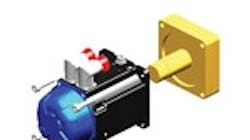Direct drive servomotors
Boosting throughput while maintaining accuracy (or vice versa) is challenging. Most motor-powered motion systems require compliance correction as well as inertia matching — sometimes-competing parameters — for an effective solution. However, one servo technology eliminates the mechanical transmission commonly found between a servomotor and load, for more direct connection. Here, the motor produces high torque to drive loads through a coupling sufficiently rigid to eliminate compliance. It's a system not possible by coupling a conventional servomotor to a load, as coupling compliance usually causes unacceptable resonance.
Called cartridge direct-drive rotary (DDR) motors, these units contain all basic servomotor components — magnetic rotor, wound stator, and sine-encoder feedback device. What's unique is that cartridge motors have no bearings to support the rotor; instead, the rotor rigidly connects to the driven machine shaft through an internal compression coupling, and uses the machine's bearings for support. The motor frame mounts to the machine frame with a pilot diameter and bolt circle just like a standard servomotor.
Cartridge motor mounting
Installation typically takes less than 5 minutes: The motor slides over the shaft until a motor pilot engages a machine pilot and the housing is secured with bolts. A cap screw is removed and a wrench engages a compression coupling; this is tightened to a specified torque. The rotor is now rigidly connected to the machine shaft. An alignment pin is removed from another hole; it is inserted into first hole that becomes its storage location and the capscrew is inserted into the second. Now cables are connected and the motor is ready to run.
Mechanical transmission vs. direct drive
Above, a press machine uses a servomotor, gearbox, belt, and pulleys. The gear reducer decreases speed, increases torque, and also matches inertia between motor and load — a common approach. As the reflected inertia through a gearbox is reduced by the square of the gear ratio, a higher ratio reduces effective inertia seen by the motor.
Above right is a press feed machine at Perfecto Industries Inc., Gaylord, Mich., with a cartridge motor installed. The motor bolts directly to the machine frame and the roll shaft extends into the motor rotor. An integral compression coupling connects rotor to roll shaft, and the bearings that support the roll also support the rotor. Feed accuracy is ±0.0005, an improvement over systems with mechanical transmission, with feed accuracy of 0.002. The start/stop rate of cartridge motor systems is also twice as good as mechanical transmission, for 100% throughput improvement.
Why do regular systems require inertia matching?
Backlash in a mechanical transmission typically limits inertia ratios to 5:1 or 10:1 at the highest — so reflected load inertia must be no more than 5 to 10 times motor inertia. If this guideline goes unmet, then velocity and position control loops become impossible to tune. For very small motor movements, load is uncoupled during backlash take-up, so the only inertia seen by the motor is its own. For larger motor movements, load engages and then the motor sees that entire inertia as well. The problem is that the control loop around the motor must provide stable performance with only motor inertia for small moves, and with total inertia for large moves. It is impossible for one control loop to provide stable performance in both of these situations, particularly when load inertia is many times that of the motor. To address this and reduce inertia mismatch, designers sometimes specify a larger motor than otherwise required, or add a flywheel.
How does compliance affect system design?
Between motor and load, compliance can cause mechanical resonance that reduces servo response, or worse yet, makes the system unstable and untunable. Picture a motor shaft: It has torsional compliance, so acts as a spring and gives rise to resonance. To address the problem, motor system designers often raise resonant frequency by making the motor shaft more rigid. The shaft's diameter is made as large as possible, and its length as short (axially) as possible.
Another way to increase resonant frequency is less intuitive for those accustomed to sizing motors for inertia matching. Resonant frequency can be increased by reducing motor inertia. This does increase the ratio of load to motor inertia, but this is no problem for direct-driving cartridge motors, as they are sized for application torque and speed requirements only, and never sized for inertia matching. This approach increases the resonant frequency and makes for a higher performance servo system.
How does direct driving help?
First off, cartridge motors are installed in minutes. Assembly for some mechanical transmission systems takes hours: Brackets must be assembled and gearmotor, pulleys, and belt installed and adjusted. Parts are reduced as well: A mechanical transmission system might include bracket pieces, bolts, pulleys, setscrews, keys, a timing belt, a belt housing, a tensioning system, and a gearmotor. Cartridge motor systems replace all this with the motor and mounting bolts — which also makes for fewer parts to wear or fail.
The best planetary gearboxes have a backlash between 1 and 2 arc minutes, and that increases over time. Cartridge motor systems have absolute accuracy of 26 arc-seconds and a repeatability of 0.7 arc-seconds. Cartridge motors typically cost 20% more than comparable gearbox/motor systems: However, no additional parts or assembly costs make cartridge systems more cost effective. Finally, cartridge motor systems reduce noise by up to 20 dB, for quieter, smoother running.
This month's handy tips provided by Jeff Arnold, direct drive technology specialist at Danaher Motion, Radford, Va. For more information, call (540) 633-3400 or visit danahermotion.com.
